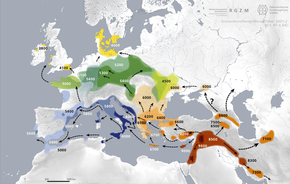「初期ヨーロッパ農耕民」の版間の差分
en:Early European Farmers (02:32, 28 November 2023) を一部翻訳して作成 タグ: モバイル編集 モバイルウェブ編集 |
→概要: en:Early European Farmers (02:32, 28 November 2023) を一部翻訳して内容追加 タグ: モバイル編集 モバイルウェブ編集 |
||
| 12行目: | 12行目: | ||
紀元前7千年紀のヨーロッパへの農耕の導入は、北西[[アナトリア]]から南東ヨーロッパへの人々の大移動と関連しており<ref>{{Cite journal |last1=Lazaridis |first1=Iosif |last2=Nadel |first2=Dani |last3=Rollefson |first3=Gary |last4=Merrett |first4=Deborah C. |last5=Rohland |first5=Nadin |last6=Mallick |first6=Swapan |last7=Fernandes |first7=Daniel |last8=Novak |first8=Mario |last9=Gamarra |first9=Beatriz |last10=Sirak |first10=Kendra |last11=Connell |first11=Sarah |last12=Stewardson |first12=Kristin |last13=Harney |first13=Eadaoin |last14=Fu |first14=Qiaomei |last15=Gonzalez-Fortes |first15=Gloria |date=2016-08-08 |title=Genomic insights into the origin of farming in the ancient Near East |journal=Nature |language=en |volume=536 |issue=7617 |pages=419–424 |doi=10.1038/nature19310 |pmid=27459054|pmc=5003663 }}</ref>、その結果、地元のバルカン半島の狩猟採集民の遺伝子プールのほとんどすべて(約98%)がアナトリアの農耕民の祖先と入れ替わったことが遺伝学的研究によって証明されている{{sfn|Mathieson et al.|2018}}<ref>{{cite news |first=Andrew |last=Curry |title=The first Europeans weren't who you might think |url=https://www.nationalgeographic.com/culture/article/first-europeans-immigrants-genetic-testing-feature |archive-url=https://web.archive.org/web/20210319032852/https://www.nationalgeographic.com/culture/article/first-europeans-immigrants-genetic-testing-feature |url-status=dead |archive-date=March 19, 2021 |work=National Geographic |date=August 2019}}</ref><ref>{{cite news |first=Laura |last=Spinney |title=When the First Farmers Arrived in Europe, Inequality Evolved |url=https://www.scientificamerican.com/article/when-the-first-farmers-arrived-in-europe-inequality-evolved/ |work=Scientific American |date=1 July 2020}}</ref>。バルカン半島では初期ヨーロッパ農耕民(EEF)は2手に分かれ、彼らはさらに西の[[ドナウ川]]([[線帯文土器文化]])あるいは西の[[地中海]]([[カルディウム土器]])に沿ってヨーロッパに進出していったようである。それにもかかわらず、[[北ヨーロッパ]]と[[東ヨーロッパ]]の大部分は初期ヨーロッパ農耕民(EEF)によって未開拓のままであった。中期新石器時代には、多くの初期ヨーロッパ農耕民EEFに由来する共同体の間で、主に男性主導で西ヨーロッパ狩猟採集民(WHG)の祖先が復活し、狩猟採集民の父系ハプログループの頻度が増加した。 |
紀元前7千年紀のヨーロッパへの農耕の導入は、北西[[アナトリア]]から南東ヨーロッパへの人々の大移動と関連しており<ref>{{Cite journal |last1=Lazaridis |first1=Iosif |last2=Nadel |first2=Dani |last3=Rollefson |first3=Gary |last4=Merrett |first4=Deborah C. |last5=Rohland |first5=Nadin |last6=Mallick |first6=Swapan |last7=Fernandes |first7=Daniel |last8=Novak |first8=Mario |last9=Gamarra |first9=Beatriz |last10=Sirak |first10=Kendra |last11=Connell |first11=Sarah |last12=Stewardson |first12=Kristin |last13=Harney |first13=Eadaoin |last14=Fu |first14=Qiaomei |last15=Gonzalez-Fortes |first15=Gloria |date=2016-08-08 |title=Genomic insights into the origin of farming in the ancient Near East |journal=Nature |language=en |volume=536 |issue=7617 |pages=419–424 |doi=10.1038/nature19310 |pmid=27459054|pmc=5003663 }}</ref>、その結果、地元のバルカン半島の狩猟採集民の遺伝子プールのほとんどすべて(約98%)がアナトリアの農耕民の祖先と入れ替わったことが遺伝学的研究によって証明されている{{sfn|Mathieson et al.|2018}}<ref>{{cite news |first=Andrew |last=Curry |title=The first Europeans weren't who you might think |url=https://www.nationalgeographic.com/culture/article/first-europeans-immigrants-genetic-testing-feature |archive-url=https://web.archive.org/web/20210319032852/https://www.nationalgeographic.com/culture/article/first-europeans-immigrants-genetic-testing-feature |url-status=dead |archive-date=March 19, 2021 |work=National Geographic |date=August 2019}}</ref><ref>{{cite news |first=Laura |last=Spinney |title=When the First Farmers Arrived in Europe, Inequality Evolved |url=https://www.scientificamerican.com/article/when-the-first-farmers-arrived-in-europe-inequality-evolved/ |work=Scientific American |date=1 July 2020}}</ref>。バルカン半島では初期ヨーロッパ農耕民(EEF)は2手に分かれ、彼らはさらに西の[[ドナウ川]]([[線帯文土器文化]])あるいは西の[[地中海]]([[カルディウム土器]])に沿ってヨーロッパに進出していったようである。それにもかかわらず、[[北ヨーロッパ]]と[[東ヨーロッパ]]の大部分は初期ヨーロッパ農耕民(EEF)によって未開拓のままであった。中期新石器時代には、多くの初期ヨーロッパ農耕民EEFに由来する共同体の間で、主に男性主導で西ヨーロッパ狩猟採集民(WHG)の祖先が復活し、狩猟採集民の父系ハプログループの頻度が増加した。 |
||
EEFの中で最も一般的な[[Y染色体ハプログループ]]は[[ハプログループG (Y染色体)|ハプログループG2a]]であり、[[ハプログループE (Y染色体)|E1b1]]や[[ハプログループR1b (Y染色体)|R1b]]も見つかっている<ref name="Hudson">{{cite book |last1=Manco |first1=Jean |title=Ancestral Journeys: The Peopling of Europe from the First Venturers to the Vikings |date=2016 |publisher=Thames & Hudson |isbn=978-0-500-77290-4 |page=98-100 |url=https://books.google.com/books?id=_pJrCwAAQBAJ&pg=PT98 |edition=Revised and Updated }}</ref>。 |
EEFの中で最も一般的な[[Y染色体ハプログループ]]は[[ハプログループG (Y染色体)|ハプログループG2a]]であり、[[ハプログループE (Y染色体)|E1b1]]や[[ハプログループR1b (Y染色体)|R1b]]も見つかっている<ref name="Hudson">{{cite book |last1=Manco |first1=Jean |title=Ancestral Journeys: The Peopling of Europe from the First Venturers to the Vikings |date=2016 |publisher=Thames & Hudson |isbn=978-0-500-77290-4 |page=98-100 |url=https://books.google.com/books?id=_pJrCwAAQBAJ&pg=PT98 |edition=Revised and Updated }}</ref>。彼らの[[ミトコンドリアDNAハプログループ|母系ハプログループ]]は主に[[ハプログループH (mtDNA)|H2]]、I、T2を含む西ユーラシア系統で構成されていたが、中央ヨーロッパの農民のかなりの数が東アジアの母系[[ハプログループN (mtDNA)#分布|N9a]]に属していた、 |
||
これは現代のヨーロッパ人にはほとんど存在しないが、[[東アジア]]では一般的である<ref name="Hudson" /><ref>{{cite journal |last1=Guba |first1=Zsuzsanna |last2=Hadadi |first2=Éva |last3=Major |first3=Ágnes |last4=Furka |first4=Tünde |last5=Juhász |first5=Emese |last6=Koós |first6=Judit |last7=Nagy |first7=Károly |last8=Zeke |first8=Tamás |title=HVS-I polymorphism screening of ancient human mitochondrial DNA provides evidence for N9a discontinuity and East Asian haplogroups in the Neolithic Hungary |journal=Journal of Human Genetics |date=November 2011 |volume=56 |issue=11 |pages=784–796 |doi=10.1038/jhg.2011.103 |pmid=21918529 |s2cid=20827921 |url=https://www.nature.com/articles/jhg2011103 |language=en |issn=1435-232X}}</ref><ref>{{cite journal |last1=Derenko |first1=Miroslava |last2=Malyarchuk |first2=Boris |last3=Grzybowski |first3=Tomasz |last4=Denisova |first4=Galina |last5=Rogalla |first5=Urszula |last6=Perkova |first6=Maria |last7=Dambueva |first7=Irina |last8=Zakharov |first8=Ilia |title=Origin and Post-Glacial Dispersal of Mitochondrial DNA Haplogroups C and D in Northern Asia |journal=PLOS ONE |date=21 December 2010 |volume=5 |issue=12 |pages=e15214 |doi=10.1371/journal.pone.0015214 |pmid=21203537 |pmc=3006427 |language=en |issn=1932-6203 |doi-access=free }}</ref>。 |
|||
==脚注== |
==脚注== |
||
2023年12月8日 (金) 03:00時点における版
初期ヨーロッパ農耕民(EEF)、第一ヨーロッパ農耕民 (FEF)、新石器時代ヨーロッパ農耕民、古代エーゲ海農耕民、またはアナトリア新石器時代農耕民 (ANF)は、ヨーロッパと北西アフリカ(マグレブ)に農耕をもたらした初期新石器時代の農耕民の別個のグループを説明するために使用される名前である。中東からヨーロッパへの農耕の伝播は長い間考古学によって認識されてきたが、この伝播がこれらの農耕民の移住と強く相関しており、単なる文化交流によるものではなかったことが確認されたのは、最近の考古遺伝学の進歩によるものである。
初期ヨーロッパ農耕民は紀元前7,000年頃から小アジアから南東ヨーロッパを経由してヨーロッパに移動し、徐々に北と西に広がり、イベリア半島を経由して北西アフリカに到達した。遺伝学的研究によって、初期ヨーロッパの農耕民はアナトリアの新石器時代の農耕民に少数派の西ヨーロッパ狩猟採集民(WHG)が寄与したものとしてモデル化できることが確認されており、地域差が大きい。ヨーロッパの農耕民と狩猟採集民は、地域によっては共存し、交易も行っていたが、その関係は必ずしも平和的なものではなかったことを示す証拠もある。その後4,000年ほどの間に、ヨーロッパは農耕社会へと変貌し、西ヨーロッパ狩猟採集民(WHG)は周縁へと追いやられた。
銅器時代から青銅器時代初期にかけて、西部ステップ牧畜民の祖先を持ち、おそらくインド・ヨーロッパ語を話すヤムナヤ文化の人々に関連する集団によるポントス・カスピ海草原からの新たな移住によって、初期ヨーロッパの農耕民文化は圧倒された。再び集団が混合し、初期ヨーロッパ農耕民(EEF)の祖先は現代のヨーロッパの集団によく見られ、特にサルデーニャ人やバスク人などの南ヨーロッパ人に初期ヨーロッパ農耕民(EEF)の祖先が最も多い[1]。
概要

アナトリア新石器時代の集団は、その祖先のほとんどをアナトリア狩猟採集民(英語: Anatolian hunter-gatherers)(AHG)に由来し、それにわずかなイラン・コーカサスやレヴァント関連からの遺伝子の流入を伴っていたことから、農耕はこれらの狩猟採集民によってその場で採用されたものであり、人口拡散(英語: demic diffusion)によってこの地域に広まったものではないことが示唆される[2]。アナトリア狩猟採集民(AHG)と初期ヨーロッパ農耕民(EEF)の祖先は最終氷期極大期の4万5千yaから2万6千yaの間に西ヨーロッパ狩猟採集民(WHG)から分裂し、25kyaから14kyaの間にコーカサス狩猟採集民(英語: Caucasian Hunter-Gatherer)(CHG)から分裂したと考えられている[3]。
紀元前7千年紀のヨーロッパへの農耕の導入は、北西アナトリアから南東ヨーロッパへの人々の大移動と関連しており[4]、その結果、地元のバルカン半島の狩猟採集民の遺伝子プールのほとんどすべて(約98%)がアナトリアの農耕民の祖先と入れ替わったことが遺伝学的研究によって証明されている[5][6][7]。バルカン半島では初期ヨーロッパ農耕民(EEF)は2手に分かれ、彼らはさらに西のドナウ川(線帯文土器文化)あるいは西の地中海(カルディウム土器)に沿ってヨーロッパに進出していったようである。それにもかかわらず、北ヨーロッパと東ヨーロッパの大部分は初期ヨーロッパ農耕民(EEF)によって未開拓のままであった。中期新石器時代には、多くの初期ヨーロッパ農耕民EEFに由来する共同体の間で、主に男性主導で西ヨーロッパ狩猟採集民(WHG)の祖先が復活し、狩猟採集民の父系ハプログループの頻度が増加した。
EEFの中で最も一般的なY染色体ハプログループはハプログループG2aであり、E1b1やR1bも見つかっている[8]。彼らの母系ハプログループは主にH2、I、T2を含む西ユーラシア系統で構成されていたが、中央ヨーロッパの農民のかなりの数が東アジアの母系N9aに属していた、 これは現代のヨーロッパ人にはほとんど存在しないが、東アジアでは一般的である[8][9][10]。
脚注
- ^ Kılınç, Gülşah Merve; Omrak, Ayça; Özer, Füsun; Günther, Torsten; Büyükkarakaya, Ali Metin; Bıçakçı, Erhan; Baird, Douglas; Dönertaş, Handan Melike et al. (2016-10-10). “The Demographic Development of the First Farmers in Anatolia”. Current Biology 26 (19): 2659–2666. doi:10.1016/j.cub.2016.07.057. ISSN 0960-9822. PMC 5069350. PMID 27498567.
- ^ Krause, Johannes; Jeong, Choongwon; Haak, Wolfgang; Posth, Cosimo; Stockhammer, Philipp W.; Mustafaoğlu, Gökhan; Fairbairn, Andrew; Bianco, Raffaela A. et al. (2019-03-19). “Late Pleistocene human genome suggests a local origin for the first farmers of central Anatolia” (英語). Nature Communications 10 (1): 1218. Bibcode: 2019NatCo..10.1218F. doi:10.1038/s41467-019-09209-7. ISSN 2041-1723. PMC 6425003. PMID 30890703.
- ^ Marchi, Nina; Winkelbach, Laura; Schulz, Ilektra; Brami, Maxime; Hofmanová, Zuzana; Blöcher, Jens; Reyna-Blanco, Carlos S.; Diekmann, Yoan et al. (May 2022). “The genomic origins of the world's first farmers”. Cell 185 (11): 1842–1859.e18. doi:10.1016/j.cell.2022.04.008. ISSN 0092-8674. PMC 9166250. PMID 35561686.
- ^ Lazaridis, Iosif; Nadel, Dani; Rollefson, Gary; Merrett, Deborah C.; Rohland, Nadin; Mallick, Swapan; Fernandes, Daniel; Novak, Mario et al. (2016-08-08). “Genomic insights into the origin of farming in the ancient Near East” (英語). Nature 536 (7617): 419–424. doi:10.1038/nature19310. PMC 5003663. PMID 27459054.
- ^ Mathieson et al. 2018.
- ^ Curry, Andrew (2019年8月). “The first Europeans weren't who you might think”. National Geographic. オリジナルの2021年3月19日時点におけるアーカイブ。
- ^ Spinney, Laura (2020年7月1日). “When the First Farmers Arrived in Europe, Inequality Evolved”. Scientific American
- ^ a b Manco, Jean (2016). Ancestral Journeys: The Peopling of Europe from the First Venturers to the Vikings (Revised and Updated ed.). Thames & Hudson. p. 98-100. ISBN 978-0-500-77290-4
- ^ Guba, Zsuzsanna; Hadadi, Éva; Major, Ágnes; Furka, Tünde; Juhász, Emese; Koós, Judit; Nagy, Károly; Zeke, Tamás (November 2011). “HVS-I polymorphism screening of ancient human mitochondrial DNA provides evidence for N9a discontinuity and East Asian haplogroups in the Neolithic Hungary” (英語). Journal of Human Genetics 56 (11): 784–796. doi:10.1038/jhg.2011.103. ISSN 1435-232X. PMID 21918529.
- ^ Derenko, Miroslava; Malyarchuk, Boris; Grzybowski, Tomasz; Denisova, Galina; Rogalla, Urszula; Perkova, Maria; Dambueva, Irina; Zakharov, Ilia (21 December 2010). “Origin and Post-Glacial Dispersal of Mitochondrial DNA Haplogroups C and D in Northern Asia” (英語). PLOS ONE 5 (12): e15214. doi:10.1371/journal.pone.0015214. ISSN 1932-6203. PMC 3006427. PMID 21203537.
